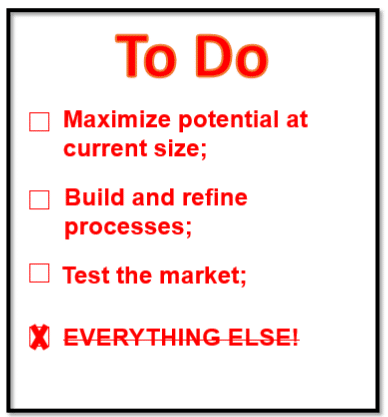Success can often lead to failure. We see this time and time again. In life, we see this in the athlete who climbs the ladder to peak performance, but at a certain point, reaches a plateau. We see this with students who strive to be the top of their class, but fall short because someone else is slightly better at that critical moment. And, of course, we see this in business, where an entrepreneur turns an idea into a business, but then grows too soon and too fast.
One of my favorite books, Essentialism: The Disciplined Pursuit of Less by Greg McKeown, discusses first-hand how success can lead to professional and personal failure. As McKeown states, essentialists think virtually nothing is essential, while non-essentialists think virtually everything is essential. These are two completely different mindsets.
This idea seems completely counterintuitive. We often fall into the trap that, in order to be successful, you have to do everything. Realistically, doing everything will make you less successful because you cannot focus on the things that matter most. That is a problem that most business owners face.
In today’s post, I’d like to discuss this idea as it relates to expanding your business. I am often contacted to discuss the growth of a business. In many instances, the owner wishes to grow and grow fast. Part of this is usually driven by demand, and part of it is driven by an inner drive that moves the entrepreneur to seek growth; often times simply for growth’s sake.
More specifically, I am going to cover three ways in which you can determine how to successfully grow your business by applying the principles of essentialism.
First, is growing your business outward essential right now? Have you maximized your potential at your current size? When you look at your business, can you honestly say that you are getting maximum return under your current structure, with your current staff and your current setup? If you can’t, you are not ready to grow. Rather than growing, fix what is not working right, tweak your process, and determine what your highest leveraged outcome may be.
Second, it is essential to take a look at your processes. Are your processes tried and true? Do you even have a process at all? These are vital questions to think about before you switch from a stabilization mindset to a growth mindset. Alleviating inefficiencies and productivity issues before you grow will help you build a solid foundation for your business from which you can grow in the future.
Third, have you tested the market? Does a bigger market exist? If so, where is this market and how do you attack it? Many entrepreneurs have grand visions of expansion. But most, when pressed, struggle to explain what that expansion looks like and where it would take place. Before you expand, you must map it out. Is your market clustered? Is it more isolated or in one-off locations? Knowing and understanding this information is essential to successful expansion.
It is easy to do more. In fact, it is easiest to do more. What is hard is doing less. Before you make the decision to grow, think about why you are growing, what you are trying to achieve, and who you are trying to serve. You may just realize that the growth you truly need is within your current size and structure, not by expanding beyond it.

